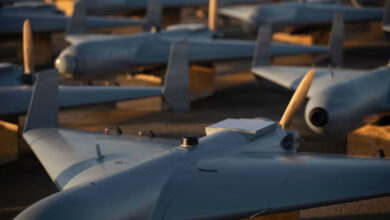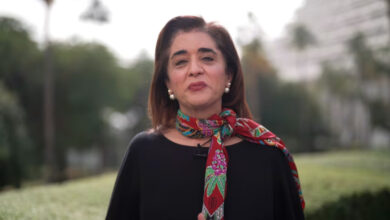
Construction of an enormous trench across Libya, dug by Russian-backed mercenaries Wagner, is raising fears that foreign fighters will not withdraw from the country by Saturday, as a UN-brokered peace deal insists.
US officials are also concerned over the long-term goals of the Kremlin ally in the war-torn state. One intelligence official notes that the trench is a sign that Wagner, which, the official said, has its largest global presence in Libya, is “settling in for the long haul.”
The trench, which extends dozens of kilometers south from the populated coastal areas around Sirte towards the Wagner-controlled stronghold of al-Jufra, can be seen on satellite imagery and is bolstered by a series of elaborate fortifications.
CNN has contacted the Russian government for comment and received no response.
A simmering conflict has split Libya for months, with the internationally-recognized Government of National Accord (GNA) in the capital Tripoli, backed by Turkey, in an enduring stalemate against the Libya National Army (LNA) in the East, led by General Khalifa Haftar and backed by Russia and the United Arab Emirates.
This recent conflict has claimed more than 2,000 lives, according to UN data, and shattered an oil-rich, strategically vital Mediterranean state. An October peace deal, brokered by the United Nations, was meant to see all foreign forces leave the country by January 23, one of a number of confidence-building measures.
The trench and fortifications appear designed to impede or stop a land attack on LNA controlled areas in the east, running through the populated coastal areas of Libya that have seen the most clashes since the 2011 fall of the regime of Moammar Gadhafi.
The GNA have posted images of excavators and trucks creating the ditch and berm that runs alongside it and said that work appeared ongoing as recently as this month.
The trench, the US intelligence official said, is another reason “we see no intent or movement by either Turkish or Russian forces to abide by the UN-brokered agreement. This has the potential to derail an already fragile peace process and ceasefire. It will be a really difficult year ahead.”
Open-source monitoring says it has mapped a series of more than 30 defensive positions dug into the desert and hillsides that stretch for about 70 kilometres.
Satellite imagery from Maxar, seems to show both the trench stretching along a main road, and the fortifications dug, also by Wagner mercenaries and their contractors.
Images show a build-up of defenses around the Jufra airbase, and also the Brak airfield further south, where apparent radar defenses have been installed and fortified.
Salaheddin Al-Namroush GNA Defense Minister, said to CNN: “I don’t think anyone digging a trench today and making these reinforcements is leaving anytime soon.”
Claudia Gazzini, from the International Crisis Group, told CNN the trench was “indeed worrying,” and that talk of it “has been circulating between diplomats for the past few weeks. It is ongoing and would suggest Moscow is keen to cement its presence in Libya.”
Analysts have said the Kremlin is keen to boost its military presence and influence in the Mediterranean, along NATO’s southern underbelly, with the added bonus of involvement in and profit from Libya’s oil industry.
Gazzini added there were repeated reports that both sides continued to maintain and build a presence of foreign mercenaries, with the GNA also accused of boosting its supplies of military equipment, under a public deal with Turkey to support its armed forces.
The US intelligence official said the number of mercenaries on both the GNA and LNA sides was relatively consistent: An estimated 10,000 were in currently Libya, according to a September AFRICOM report on the issue.
The Libyan deployment of about 2,000 Wagner foreign mercenaries — thought to be mostly Russian or former Soviet Union nationals — is the private military company’s largest worldwide, the US official said.
A spokesman for the LNA, Major General Khaled al-Mahjoub, confirmed the existence of the trenches to CNN, but described them as “temporary” sand barriers and trenches, in “an open area… for defense and fighting.” He denied the presence of 2,000 Wagner mercenaries, and said there were consultants “announced a long time ago.”
But, a confidential UN report in June, obtained by CNN described the Wagner fighters as “an effective force multiplier.”
Last year, Russian President Vladimir Putin said that there were no Russians in Libya, but if there are they are not representing Russia. Russia has always denied it uses mercenaries to fight for it.
Pictures of the digging of trenches between Sirte and Jufra surfaced in the summer of 2020.
Despite an arms embargo, UN inspectors recorded dozens of Russian flights into Libya throughout 2020.
The US Africa Command publicly called Russia out for the expansion, saying it was similar to actions in Syria.
In June, the head of the defense committee in the upper house of the Russian parliament, Viktor Bondarev, said the US claim was “stupidity” and suggested they were old Soviet planes from somewhere else in Africa.
A western diplomat with knowledge of arms movements into Libya said Russian flights into the country had dropped from their peak of 93 in August down to just over a dozen monthly at the end of 2020.” They’re just sustaining on the ground,” he said, adding that Turkey was flying in similar numbers.
Turkey’s military is open about its desire for a permanent presence, posting images of its military giving the GNA “Base Defence Training” in the past week.
“It’s a comprehensive effort,” said the US official. “They’re constructing facilities, bringing in personnel and equipment. They’ve got the HAWK air defense missile batteries, 3D [KALAKAN] radar.”
Satellite imagery of the al-Khoms port shows minor modifications that suggest it may be being readied for a longer-term Turkish naval presence, which the GNA’s al-Namroush has denied.
A senior Turkish security official told CNN they “continue to offer military training, cooperation and advice…according to the GNA’s needs and demands.”
By January 2021, more of the trench digging was captured on camera along the road connecting Sirte to Jufra.
The thousands of Syrian mercenaries that Turkey has flown into and supported in Libya have been used elsewhere too, the US intelligence official revealed. During Turkey’s support for the Azerbaijani government during their recent conflict with Armenia, planes carried hundreds of Syrian mercenaries to Azerbaijan, to assist Turkey’s ally in their war with Armenia, the US official said.
“It did appear that there was some movement of some of the Syrian mercenary forces in the direction of the conflict in [Nagorno Karabakh]. Smaller numbers, in the lower hundreds,” the official added.
The Russian-backed Wagner forces are intended to provide Moscow with influence but not liability, analysts said. Jalel Harchaoui, a senior fellow at the Global Initiative Against Transnational Organized Crime, said Wagner mercenary forces were “by definition disposable” — and a “force that does not exist, according to the official version of the Russian state. It doesn’t mean it’s not formidable, fearsome and fairly effective,” but that it provides the greatest flexibility for the Kremlin.
Gazzini added: “Russian policy in Libya is opaque — what Russia wants to do. From evidence on the ground, it sounds like they want to consolidate their influence, or want to find a way out.”
Yet the US official added the Russian build-up amounted now to significant personnel and advanced equipment, but one that presented ethical concerns. “Fourth generation fighter jets and Pantsir missile systems are being operated by a less capable, poorly-trained Wagner mercenaries,” the official said.
“There are complex challenges in Libya, including al Qaeda and ISIS, and mercenaries with their poor level of training, experience, and lack of respect for human rights and international law, make those weapons systems in those hands the most concerning.”
While the Wagner presence and trench seems to convey an advantage for the LNA’s head General Haftar, the Russian presence seems more geared to Moscow’s agenda, than the support of Haftar, analysts said.
The Western diplomat said Haftar needed a continued conflict in Libya to maintain relevance. “He becomes irrelevant overnight if the conflict finishes,” said the diplomat. “And it if does not finish on his terms he becomes vulnerable to war crimes allegations etcetera.”
By Nick Paton Walsh and Sarah El Sirgany, CNN
IMAGE: The trench, which extends dozens of kilometers south from the populated coastal areas around Sirte, can be seen on satellite imagery and is bolstered by elaborate fortifications. Satellite image provided by MAXAR Technologies.




